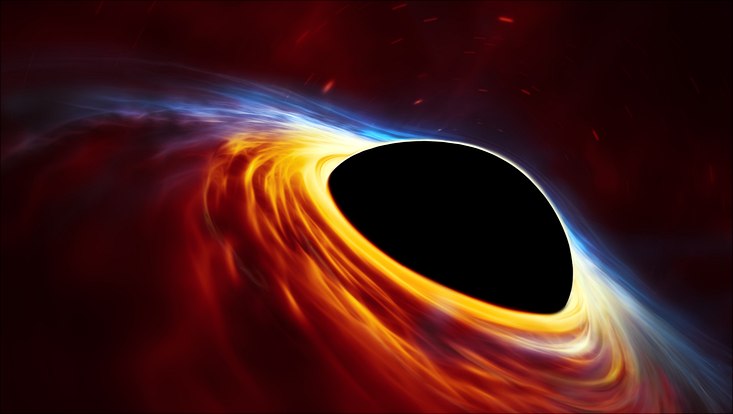Revolutionary observationBlack holes: what are they, actually?
10 April 2019, by Felix Willeke
The international research project Event Horizon has now succeeded in photographing a black hole for the first time. But what is a black hole, actually, and what does it do? We’ve asked Prof. Dr. Jochen Liske from the Sternwarte, Universität Hamburg’s observatory.
Can you, as Professor for Observational Astronomy, explain to us what black holes are?
A black hole is an object with such immense gravity that nothing that gets near it can ever escape it: if something “falls in,” it will never come back out. This is even true of light.
To illustrate this, let’s first think about our own Earth. There is a certain gravity working upon Earth’s surface. For example, if you throw a tennis ball straight up into the air, it reaches a certain height before falling back to the ground. This depends upon the initial speed. The greater the initial speed, the higher the ball will go. If the initial speed is more than 11.2 km/s (roughly 40,320 km/h), the ball would not come down again: it would escape Earth’s gravitational pull. This special initial speed is called “escape velocity,” a descriptive measurement for the force of gravity. The force of an object’s gravity depends on both its mass and its size. If Earth were smaller but had the same mass, its escape velocity would be much bigger. If it were the size of a pea, Earth’s escape velocity would equal the speed of light. Since nothing can move faster than light, then nothing would be able to escape the surface of this pea-sized Earth and we would have a black hole.
Albert Einstein had already predicted black holes. It only became possible to prove their existence much later, however, based on astrophysical observations: for example, years-long observation of the movement of stars or proof of gravitational waves.
Where are these black holes?
As far as we know, black holes only exist in the far reaches of the Universe. We are aware of black holes of varying size or mass, what we call “stellar black holes,” which have roughly the mass of a few suns; a solar mass is 1.99 quadrillion tons. These black holes are the remains of huge, extinguished stars. They can be found all over our own galaxy, the Milky Way, and presumably, they can be found in all other galaxies. However, there are so few of these holes that we don’t have to be afraid that one of them is going to sweep through our solar system tomorrow. Furthermore, we also know of supermassive black holes with a solar mass of millions or even billions. These, however, only appear in the center of galaxies—and in the center of our Milky Way.
What impact do black holes have?
The impact of a black hole lies in its enormous gravitational pull, although that only plays a role if you get too close to it. Observed from afar, the impact of a black hole does not differ at all from the impact of a normal object with the same mass. For example, if the sun collapses into a black hole tomorrow, it would have no effect on the orbits of the planets in our solar system, since these are determined by the sun’s gravitational pull. If, however, you get to close, things can get dicey. The hole is just a point surrounded by what is known as the “event horizon.” If something, let’s say a rocket, traverses this, it can’t return. There are also enormous tidal waves near the horizon, comparable to those responsible for the ebb and tide on Earth, and these would rip everything apart. By measuring the movement of matter in the immediate vicinity of a black hole, we can draw conclusions about the nature of the black hole as well as check the validity of Albert Einstein’s predictions.
Further information
Researchers from the international research project Event Horizon Telescope have successfully photographed a black hole. See the project homepage for more details.
See the European Southern Observatory’s homepage for a video about the image.




